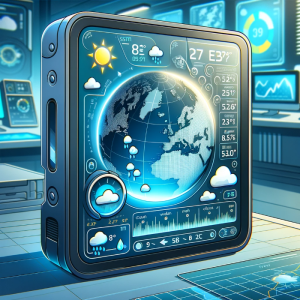
How Machine Learning is Transforming Climate Science
The Summer of 2023: A Heatwave to Remember
Imagine stepping outside on a blistering summer day, the heat so intense it feels like you’re walking into an oven. The air shimmers, the ground is scorching, and all you can think about is finding the nearest air-conditioned refuge. This was the reality for millions across Southcentral North America during the sweltering June of 2023—a heatwave so severe it broke records, strained power grids, and left communities grappling with its aftermath. But what if I told you that this heatwave, as oppressive as it was, offers us a glimpse into our future climate, shaped by human activities? (well, first, I’ve be one in a huge chorus of people)
Understanding the connection between global warming and extreme weather events has always been a complex puzzle in climate science. However, a groundbreaking new study is shedding light on this issue, using machine learning to reveal how much hotter—and more frequent—these events are likely to become.
A New Era of Climate Prediction
The traditional approach to studying extreme weather has been a mix of probability and historical data analysis. Scientists have long relied on models and simulations to estimate the likelihood of an event like a heatwave and how much human-induced climate change might be to blame. However, these methods, while valuable, have limitations. They often can’t account for the specific atmospheric conditions that lead to a particular event, nor can they easily simulate what might have happened if the world were a little cooler—or hotter.
Enter machine learning, a powerful tool that is revolutionizing our ability to understand and predict complex phenomena. In this new study, researchers developed a machine learning-based framework that goes beyond traditional methods. Using convolutional neural networks (CNNs)—a type of deep learning model particularly good at processing grid-like data, such as weather maps—scientists were able to create what they call “dynamically consistent counterfactuals.”
What If? The Power of Counterfactuals
Let’s pause for a moment and consider a simple question: What if? What if the world had not warmed as much as it has since the Industrial Revolution? What if global temperatures were still at pre-industrial levels? This is the essence of a counterfactual scenario—an exploration of what might have happened under different circumstances.
In this study, the researchers applied their machine learning model to the extreme heat event in Southcentral North America in June 2023, as well as several other historical heatwaves. They asked: How much of this heat can we attribute to global warming? And what would this heatwave have looked like in a world where global temperatures were 1°C, 2°C, or even 4°C higher or lower?
The results were striking. The study estimated that the temperatures during the June 2023 heatwave were 1.18°C to 1.42°C warmer due to human-induced global warming. In other words, without the impact of climate change, this heatwave would have been notably less severe. But the implications go even further. The model predicts that as global temperatures continue to rise, heatwaves like the one in June 2023 will not only become more common but also more intense.
The Future is Hotter Than We Think
So, what does this mean for our future? According to the study, if global temperatures reach 2.0°C above pre-industrial levels—a threshold we’re rapidly approaching—similar heatwaves could occur as frequently as once or twice a year. And if we continue on our current trajectory, pushing global temperatures 4.0°C higher, we could be looking at an alarming increase in both the frequency and severity of these events.
But it’s not just about more heatwaves. The study also revealed that the relationship between global temperature and extreme heat is not linear. As the world gets hotter, the frequency of extreme events increases at a faster rate than the temperature itself. This means that every fraction of a degree matters—every small reduction in global warming could significantly decrease the likelihood of extreme heat events.
Why This Matters: The Human Impact
Now, you might be wondering, why should we care about these findings? After all, we’ve always had hot summers, right? While it’s true that heatwaves are a natural part of the climate system, the scale and intensity of these events are changing in ways that have serious implications for our health, economy, and environment.
Consider the impact of the June 2023 heatwave. Hospitals saw a surge in heat-related illnesses, agricultural yields plummeted due to scorched fields, and energy grids struggled under the increased demand for air conditioning. The most vulnerable—elderly individuals, outdoor workers, and those without access to cooling—suffered the most. As heatwaves become more frequent and severe, these challenges will only grow, placing immense pressure on communities and governments.
Moreover, heatwaves are just one piece of the puzzle. As global temperatures rise, we’re also likely to see more extreme weather events of all kinds—floods, droughts, hurricanes—all of which can have devastating effects on human lives and livelihoods.
The Role of Machine Learning in Climate Resilience
The findings from this study are not just academic; they offer a practical tool for policymakers and planners. By understanding how much more extreme our weather could become, governments can better prepare for the future. For instance, cities could use this information to design more resilient infrastructure, develop early warning systems, and implement heat action plans to protect vulnerable populations.
Machine learning models, like the one used in this study, also provide a cost-effective way to perform rapid, real-time analysis of extreme events as they happen. This means that in the future, we could have near-instantaneous assessments of how much of a given heatwave, flood, or storm can be attributed to climate change—information that could be crucial for disaster response and recovery efforts.
What Can We Do?
As we look to the future, the message is clear: Every action we take to reduce greenhouse gas emissions can help mitigate the worst impacts of climate change. Whether it’s transitioning to renewable energy, improving energy efficiency, or protecting and restoring natural ecosystems, the choices we make today will shape the climate of tomorrow.
But it’s not just up to policymakers and scientists. Each of us has a role to play in building a more sustainable world. By staying informed, reducing our own carbon footprint, and advocating for stronger climate policies, we can all contribute to a future where extreme heatwaves and other climate-related disasters are less frequent, less severe, and less deadly.
Join the Conversation
What do you think? How should we prepare for a future with more frequent and intense heatwaves? What steps can we take individually and collectively to reduce the impact of global warming on extreme weather events? Share your thoughts in the comments below—we’d love to hear from you!
Explore and Learn with Science:
Dive into groundbreaking research and inspiring stories with ‘This Week in Science’! Perfect for teachers and science enthusiasts, our free weekly newsletter expands your horizons in teaching and learning. Join us today and reshape your engagement with science. If you liked this blog, please share it! Your referrals help This Week in Science reach new readers.



